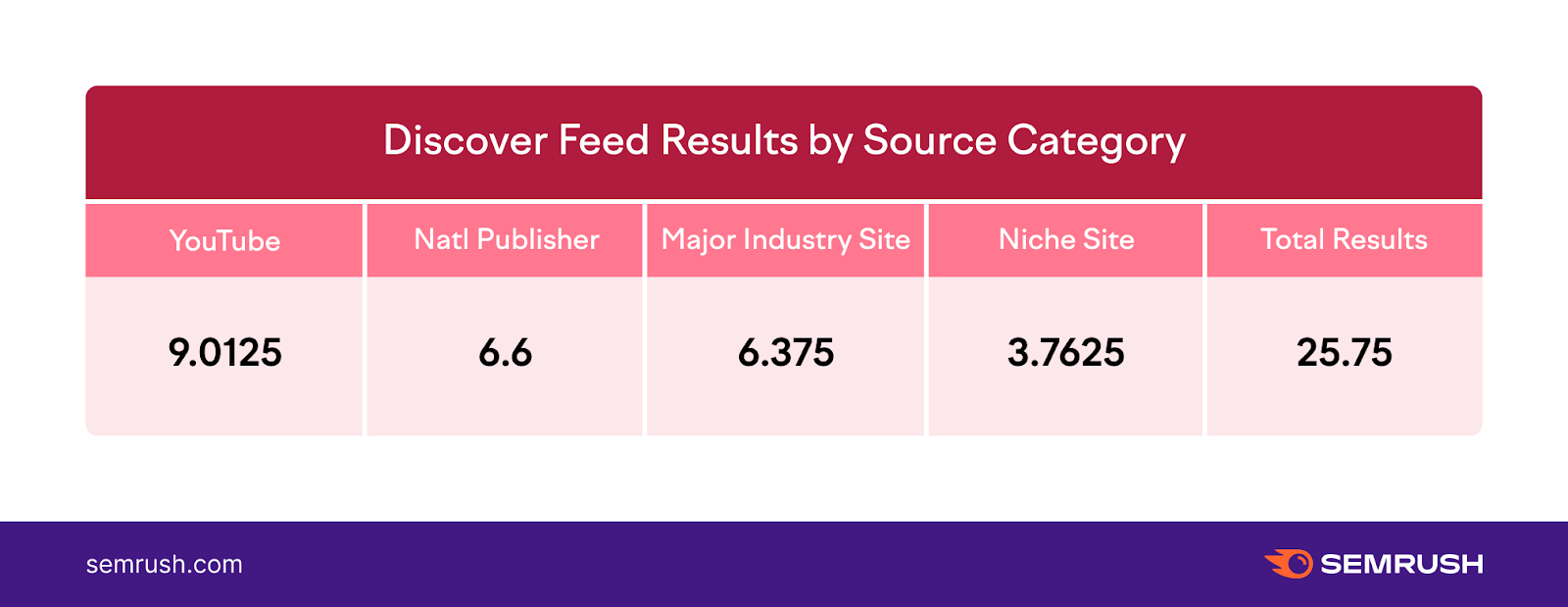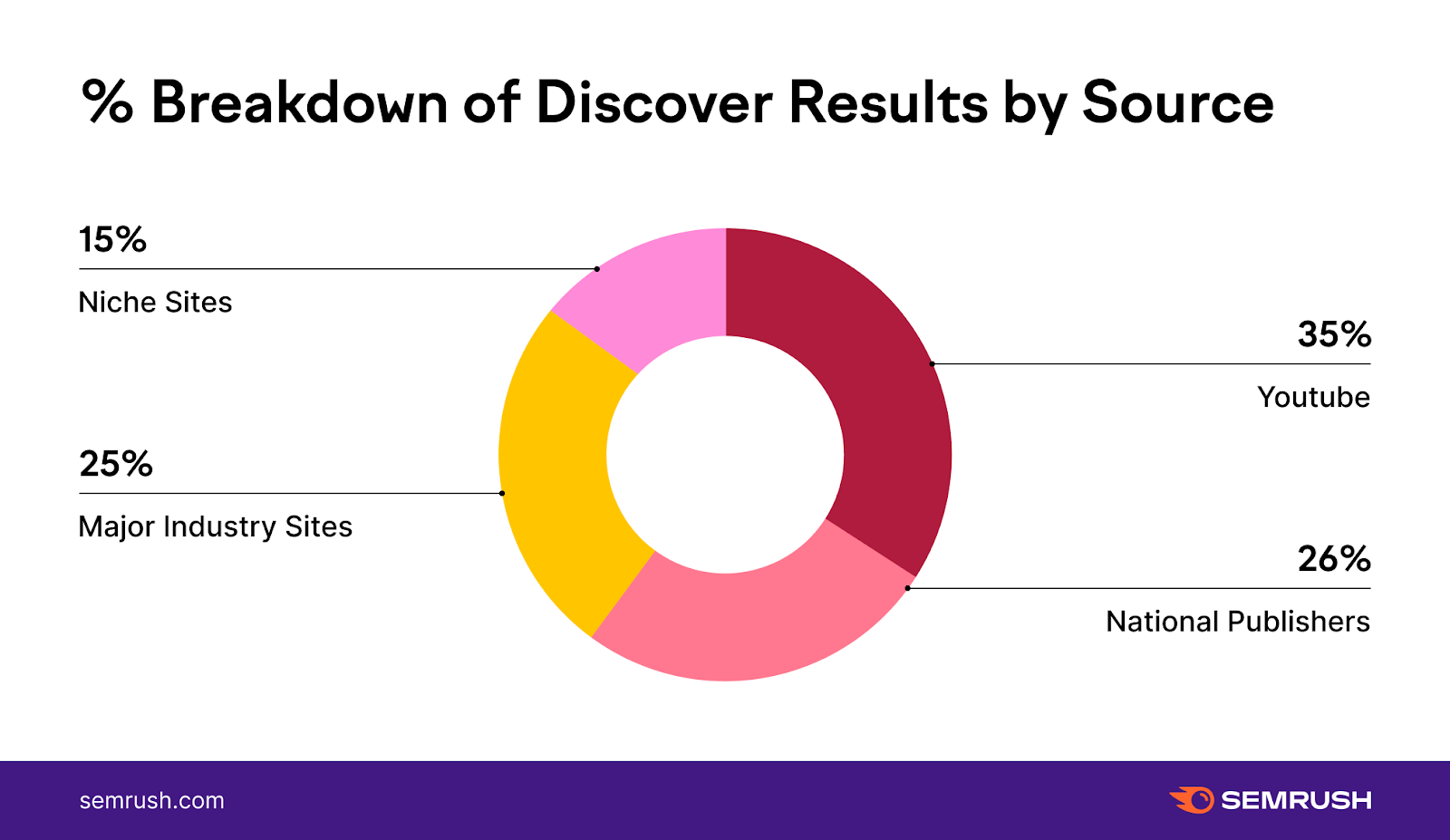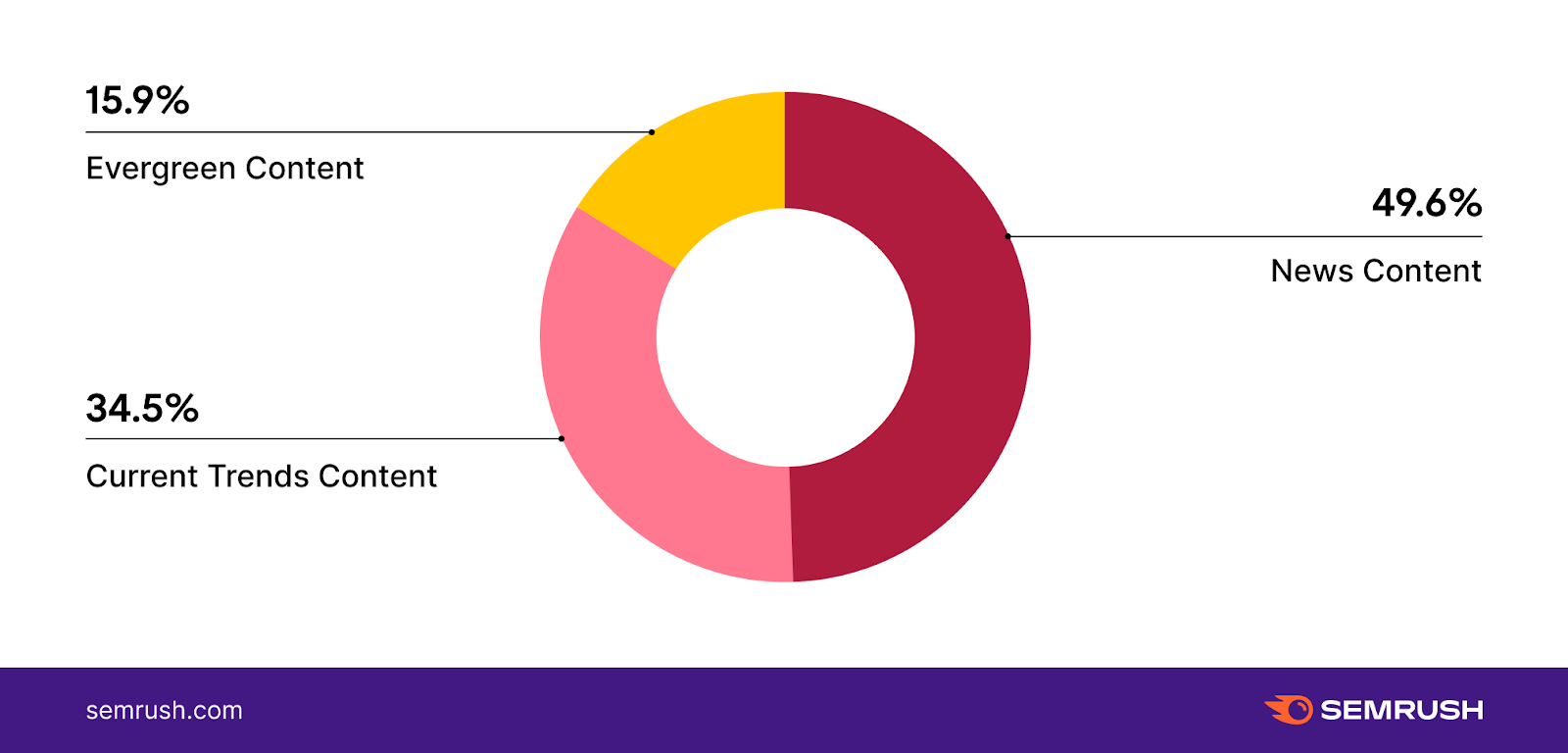Google’s Discover feed is legitimately one of the more elusive organic ecosystems. Ranking on the Google SERP itself involves an optimization process that is at least somewhat tangible. Discover, however, is a personalized feed. This means that outside of things like using the correct image formats, the selection process is far more ethereal and holistic.
Naturally, this makes pinning down what works and doesn’t work for appearing in Google’s Discover a bit intangible. Moreover, it makes understanding the ecosystem itself complicated, to say the least.
In an attempt to pin things down (at least my own feed), I tracked and categorized the content Google showed me in my Discover feed for 6 months.
Here’s what I found.
Background on My Google Discover Analysis
Before we dive into the thick of it, let me explain what exactly I tracked (you could skip to the next H2, but I strongly recommend you don’t).
For five days every week — from the start of February 2021 all the way through the end of July 2021 — I went through every item in my Discover feed and categorized it all. (I did miss a day or two here and there… sue me. Also, yes, I do realize I am a crazy person for doing this for 6 months).
The feed was tracked using an Android device. This is important to know because the device matters. In the middle of monitoring my feed, I happened to get an iPhone. It was quickly apparent that I would have to keep my Android device for consistency’s sake. Aside from some of the results being different, the format on iOs diverges from that on Android. For example, under YouTube videos related to sports highlights, Google would often place a carousel of related scores under the video. Not so on iOS.
Aside from the implications of using Android over iOS to track my feed, there are two major limitations to this kind of analysis (for the record, limitations are a good thing as they help you understand how to apply information):
My Discover feed, just like your Discover feed, is specifically curated for my user profile. That is, what shows up in my feed probably doesn’t show up in your feed unless you’re both an SEO and baseball fanatic.However, that doesn’t mean that Google doesn’t take the same approach to content universally. That is to say, while the specific content varies from feed to feed, there is most likely a content paradigm that favors one type of content over another universally (i.e., news content over evergreen content).
Google Discover’s foundation on personalization brings it beyond the scope of automation. For our purposes, this means that I had to use my own limited judgment in order to classify the content found in my feed. There are many instances where the content could have “sliced” in multiple ways.A good example of this would be the baseball highlight videos that proliferated in my feed once baseball season started. I classified this as news content. That might sound funny to some. For me, these videos replaced reading a game summary recap. If I were to have seen such a recap (a written one) in my feed, that would clearly be news content. The content would be telling me what happened in yesterday’s game much like the sports section of a newspaper would. Thus, I classified these videos as “news” content. Could I have sliced it another way and labeled it as “current trends?” Sure, but I didn’t.
How I Categorized My Discover Feed
Before we can actually get into the thick of it, you do need to know how I broke down the content in my feed. Fundamentally, I broke down the content in my feed according to:
Who created the content: Who was the source of the content? What type of site or platform did the content originate from?Specifically, I categorized content sources by content coming from:
YouTube National Publishers (CNN, ESPN, U.S. News, etc.) Major Industry Sites (For example, when it came to SEO content, this included Search Engine Land, Search Engine Journal, SERoundtable, Semrush, etc.) Niche Sites (These are smaller blogs or niche-specific sites that are not industry powerhouses.) The type of content: What form of content was being shown in the feed? What kind of content was Google trying to push and in what quantities within my Discover feed?Specifically, I classified content types as follows:
News Content: The type of content related to events happening in real-time — the very content you would expect to see in the Top Stories carousel. Current Trends: While not breaking any news, this is content related to something that might be trending or timely (such as a review of a recent movie, for example). Evergreen Content: Content that would be applicable in my feed today and five years from now.Does Google Discover Show Results from Your Average Site?
To kick this off, let’s understand what kinds of sites tended to push content into my feed. Another way to think of this is where the content that populated my feed came from.
Again, I broke this down into four ways — content that came from:
YouTube National Publishers Major Industry Sites Niche SitesThe idea in tracking this was to see which sorts of sites Google prefers to use for Discover Feed content. YouTube might sound like an odd category as it’s a specific website, however, the truth is so many of the results in my feed came from YouTube that I felt compelled to consider it a category unto itself.
First things first: You need to know how many results my Discover Feed included on average. The answer to that is… 25.75.
With that, here’s the breakdown of what types of sites populated my feed on average.

In other words, 35% of the results in my feed were YouTube URLs, while 26% came from national publishers, 25% from major industry sites; and just 15% came from your average site (yes, these numbers add up to 101%... because I rounded up).

Anecdotes About the Data
YouTube was the clear winner here. Now, before you all freak out that Google is dominating Discover with URLs from its own properties, know that YouTube’s dominance only came into play as baseball season started. Prior to the kick-off of the 2021 Major League Baseball season, YouTube URLs appeared but 4.58 times within my feed on a given day, not 9 times.
Is that an odd coincidence? Not really. I’m a baseball nut. I spend a considerable amount of time watching baseball highlights on YouTube once the season starts.
This means, by the way, that Discover is storing your behavior in its databanks for a considerable amount of time. The feed waited an entire year only to push baseball highlight videos into my feed like clockwork!
It also means that the data here is quite possibly (pretty much definitely) unique to me, or my profile (i.e., a baseball nut). However, it might mean that other profiles where YouTube videos become highly relevant have feeds that behave the same way. In fact, it’s quite possible that unlike myself — a seasonal YouTube user — these profiles include a heavy dose of YouTube URLs in their feeds 365 days a year.
To me, the most notable point here is not YouTube’s domination. Rather, it’s that Google clearly does not prefer “niche sites” for placement in the Discover feed. When combined, 51% of the results in my feed came from national publishers and major industry sites. This very much appears to be a tendency towards sites that have more topical authority than the average site tends to enjoy. This makes a great deal of sense that Google is not “ranking” specific pieces of content but rather trying to cater to general user preferences. In such a context, the sites with the most topical authority aligned with those preferences overall would enjoy a larger market share.
Discover Feed Ads and Cards with No URLs
The numbers I presented above don’t include ads nor cards that do not contain a URL. That is, there is content where the source is not any website but Google itself.
 An example of a Discover feed card that does not contain a URL
An example of a Discover feed card that does not contain a URLOn average there were 4.12 URL-less cards within my Discover feed each day. Now, this is a very anecdotal figure as almost all of these cards in my feed were related to sports. Thus, if you are not a sports fan, you may not see any such card type within your feed.
What’s interesting here is how long Google seems to stick with its cards once they appear in the feed. I am a sports fan, but I don’t watch much basketball. Regardless, Google still populated my feed with cards showing the scores and schedules of various basketball games. However, and to highlight how much personalization the feed caters to, as of March 1 (i.e., the start of MLB’s spring training) these cards were predominantly related to baseball. Just like with the content per se, Google understood my preference for baseball.
For the record, as Google added more cards to my feed as the baseball season progressed, it did not remove other content. Meaning, the additional cards did not result in Google removing URLs from the Discover feed.
Parenthetically, the same was true as Google added more baseball highlight videos from YouTube to the feed. It seems Google often prefers to make the initial showing in the feed longer rather than replace results in order to keep the total number of cards under a certain threshold.
How Many Ads Are in Google’s Discover Feed
There are typically three ads within the results of the initial cards shown with Google’s Discover feed — at least there were for me.
However, during the course of my monitoring, the number of ads changed. On average, there were 1.75 ads in my feed. That number is misleading since as of April 20, 2021, Google began showing two ads in my feed each day. On July 12th, Google then added an additional ad bringing the total number of ads in my feed (on Android) to 3 each day.
Does Google Discover Show Evergreen Content?
In discussing the content within the Discover feed, Google says, “The content in Discover is automatically refreshed as new content is published, however Discover is designed to show all types of helpful content from across the web, not just newly published content.”
At the same time, there’s this general conception that Google’s Discover feed is predisposed towards news and news-related content.
Both are true. Google is predisposed towards “new” content but does show a steady dose of evergreen URLs in the feed.
Over the course of my six-month obsession with Discover, I tracked the number of instances Google showed either news content or content related to current trends, as well as evergreen content.
What I saw aligns with the idea that Discover “likes to be current” but does consider other types of content.

Evergreen content being represented by nearly 16% of all the content in the Discover feed is nothing to laugh at. That’s a tremendous opportunity to bring users to their sites with their forever content.
However, it’s pretty darn clear that Google is on the hunt for content that is relevant due to its timeliness. (Which means, when considering that Discover is a feed that Google wants to entice users with, makes total sense.)
When you combine what I called “news content” with “current trends content,” you’re talking just under 85% of all Discover content being “timely.”
To me, this is indeed the way to look at it. The content I counted as “current trends” was heavily connected to news content itself. For example, a lot of this content in my feed was an analysis of a sports team’s performance or reviews of a movie. While this kind of content is not news content per se, it’s intrinsically connected. You can’t have a piece of content analyzing the finer points of a team’s struggles without the news breaking that the team lost! Again, it’s a clear indication of how Google approaches content placement for Discover.
For the record, I do think the trends I saw here in my personal feed are representative of Google’s overall approach. First off, it makes logical sense for the reason I mentioned earlier, Google needs to pique your interest so that you visit the feed. Secondly, the categories I used here are universal. No matter what topic, there is going to be content that is evergreen, content that relates to current trends, and news content — all things being equal.
In other words, I understand why Google would swap topics based on one’s personal interest, but the type of content shown is far more universal.
That being said, here are some interesting tidbits of “Google Discover goodness” I pulled out while collecting this data:
Of the news-centric content shown in my feed, 25% of it came from YouTube. While there was an average of 25.7 results in my feed each day, the highest number of evergreen pieces was 7 over the course of six months.The latter point is really interesting to me. It means that the 16% evergreen content showing was pretty consistent. It wasn’t like one day Google showed tons of evergreen content and the next very little. Rather, Google consistently did not show an excessive amount of evergreen content over the entire period!
Defining the Indefinable
Pinning down much of anything in the Discover feed is by definition quite the task. What I’ve done here, hopefully, is to help better present the content intricacies of a user profile within the context of Google’s Discover.
The topics that I tend to enjoy may produce all sorts of variance that other content profiles would not see play out in their feeds.
Still, there are some patterns exhibited within the feed that are of a more universally perceptible nature. This includes the feed’s disposition towards news content and content related to current topics as well as the feed’s tendency (at times) towards video content. Much the way that the Google SERP offers a secondary form of media via the Video Box, Discover seems intent on adding the format to the feed when it can. Certain profiles, including my own, might be subject to the inclusion of an above-average amount of video content. However, every bone in my SEO body tells me that the inclusion of video content is built-in into how the feed is constructed.
To that, and I’ll end this escapade on this point, there’s a lot of talk about your site content and how to get it into the Discover feed and there’s not a lot of talk about your channel in the same context. I think it’s a possibly worthwhile proposition to gear your channel, when applicable, to the sort of content that Google seems to prefer in Discover. I would speculate that this is particularly advantageous when the topics you cover are “video-centric” — that there’s a strong focus on that sort of content on YouTube.
To sum it all up, Discover can be a great source of traffic. At the same time, there’s a lot of “big name” competition and limited space for certain types of content. Understanding what your target audience’s feed may look like is a great way to get some insights. My advice: Try to behave like your target profile might (under a clean Google account), and see how the feed behaves for you!
Innovative SEO services
SEO is a patience game; no secret there. We`ll work with you to develop a Search strategy focused on producing increased traffic rankings in as early as 3-months.
A proven Allinclusive. SEO services for measuring, executing, and optimizing for Search Engine success. We say what we do and do what we say.
Our company as Semrush Agency Partner has designed a search engine optimization service that is both ethical and result-driven. We use the latest tools, strategies, and trends to help you move up in the search engines for the right keywords to get noticed by the right audience.
Today, you can schedule a Discovery call with us about your company needs.
Source:


![What Kind of Content Appears in Google Discover [Case Study]](https://new.allinclusive.agency/uploads/images/what-kind-of-content-appears-in-google-discover-case-study.svg)

![How To Create a Strategic Dashboard in Excel Using Semrush Data [Excel Template Included]](https://new.allinclusive.agency/uploads/images/how-to-create-a-strategic-dashboard-in-excel-using-semrush-data-excel-template-included.svg)
